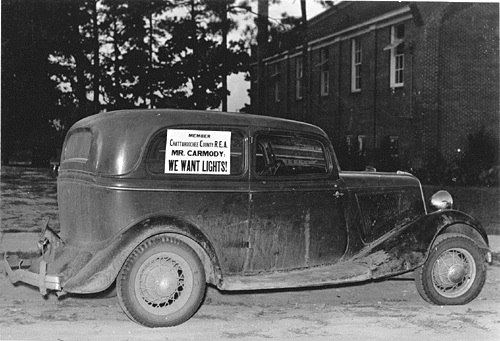We Want Lights (and Light-Rail)!
A nice photograph of Franklin D. Roosevelt accompanies today’s New York Times story about the dangers of government belt-tightening during economic depressions. As the article notes, “laissez-faire economists and Republicans” are starting to “shout louder,” (was that possible?) putting pressure on the Obama administration to end stimulus spending even though it’s doubtful the private sector will be able to make up the difference. The article suggests similarities to the 1930s, when Roosevelt, despite some economists’ advice, caved to political and business pressure to draw down stimulus spending and maintain a balanced budget.
It’s not only between elite government leaders and economists that there are parallels between then and now, however.  Although the Times story leaves them out, ordinary people had strong opinions about government spending in the 1930s, too.  Not unlike today’s Tea Partiers, there were those who saw any government intervention in the economy as sure signs the U.S. was on the path to socialism:
It seems very apparent to me that the Administration at Washington is accelerating it’s pace towards socialism and communism. Â Everyone is sympathetic to the cause of creating more jobs and better wages for labor; but…[it] will lead in the end to disaster in all classes.
…I am so confused that I wish you would write me and advise me whether it is the policy of this Administration, of which you are a very important part, to further discourage business enterprise, and eventually set up a program which eliminates private industry and effort, and replaces it with Government control of industry and labor,–call it what you will: socialism, fascism, or communism, or by any other name.
(W.L.C., “Letter to Senator Robert F. Wagner,” 1934, from Robert S. McElvaine, ed., Down & Out in the Great Depression: Letters from the Forgotten Man, (Chapel Hill, NC: University of North Carolina Press, 1983).  The author’s original spelling and grammar has been preserved.)
(At least W.L.C. was willing to admit–or feign–confusion about whether or not the government intended to be socialist or not; this strikes me as quite different than today’s Right who are convinced Obama has a secret Communist plot to nationalize all industries.)
Some folks made even more strident critiques of government spending, such as M.A., who described herself as “just an ordinary white collar worker.”  In a 1937 letter to Eleanor Roosevelt, she called Social Security “downright stealing” and said the real “forgotten men” in the country were those who had not voted for Roosevelt.  “We expect to be tramped on but we do wish the stepping would be a little less hard,” M.A. wrote, but  “security at the price of freedom is never desired by intelligent people.”*  The claims she makes, and even the rhetoric M.A. uses to make them, are strikingly similar to today’s Tea Party’s platitudes.
However, despite the criticisms of the disgruntled (and mostly privileged) few, the vast majority of Americans were strongly in favor of stimulus spending and the programs and infrastructure projects it enabled. Â The W.P.A. workers of Battle Creek, Michigan wrote to FDR at the one year anniversary of the Works Progress Administration in April 1936, asking him to continue it.* Â “It makes us feel like an American citizen to earn our own living,” they wrote. Â They called the New Deal a “great cause for Better citizens.” Â Workers like those in Michigan elected even greater majorities of New Dealers to Congress in 1934 and 1936, sending a clear message that they wanted permanent relief programs, stronger regulation and more government spending than had characterized the first two years of Roosevelt’s administration.
Or take this photograph, which illustrates the point as well as any letter or table of election returns:
The sign on the car is addressed to the head of the Rural Electrification Agency (REA), which developed electrical infrastructure (power lines, hydroelectric dams) and cooperatives for farmers to buy electricity and electric appliances. Â Only about 10% of rural Americans had electric power in the early 1930s, compared to 90% of urban residents. Â Utility companies had argued that it was too expensive to set up power grids in sparsely populated areas. Â Business leaders and some Congressmen feared that government-run programs like the REA were unfair, possibly socialist interventions in the economy. Â However, as the photographer noted, when power radiated outward from REA projects like the Tennessee Valley Authority, it “created a desire for electricity in all adjacent areas.” Â Government projects also inspired private companies to expand electricity to previously unserved areas (and the new customers who lived there).
The photographer speculated that this person drove in from an un-electrified part of Georgia or Tennessee to make his or her wants known at the 1938 dedication of an REA cooperative in Barnesville, Georgia. Â The exclamation point indicates the fervency of the car owner’s desire for the benefits of stimulus spending; the muddy tires and running board indicate the rough rural roads the person traveled to make his point.
 The stimulus package has been directed to similar infrastructure improvement projects today, like the repairs at the Union Square subway station in New York City.  The other day I noticed some impressive tiger stripes on a sign at 14th Street.  I looked up TIGER, which stands for “Transportation Investment Generation Economic Recovery.”  TIGER grants fund public transportation infrastructure improvements through the 2009 stimulus bill; $1.5 billion in TIGER grants have been awarded out of Obama’s first (and it seems, only) stimulus bill.  Like rural electrification in the 1930s, the projects not only put people to work and develop much-needed infrastructure, they also accomplish what private enterprise has not.  Only this time, instead of lights, it’s light-rail.  Maybe it’s time I made some signs to post in the windows of the N train?
The stimulus package has been directed to similar infrastructure improvement projects today, like the repairs at the Union Square subway station in New York City.  The other day I noticed some impressive tiger stripes on a sign at 14th Street.  I looked up TIGER, which stands for “Transportation Investment Generation Economic Recovery.”  TIGER grants fund public transportation infrastructure improvements through the 2009 stimulus bill; $1.5 billion in TIGER grants have been awarded out of Obama’s first (and it seems, only) stimulus bill.  Like rural electrification in the 1930s, the projects not only put people to work and develop much-needed infrastructure, they also accomplish what private enterprise has not.  Only this time, instead of lights, it’s light-rail.  Maybe it’s time I made some signs to post in the windows of the N train?
*Also in McElvaine’s Down & Out in the Great Depression.
(Historical documents and texts from this post will be available in ASHP/CML’s forthcoming database of primary sources for history educators.)
Last 5 posts by Leah Nahmias
- Teaching "What This Cruel War Was Over" - March 28th, 2011
- State of Siege and Public Memory at Ole Miss - March 25th, 2011



